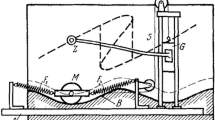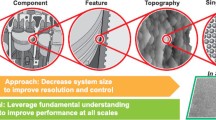Abstract
The formation of tribomaterial during sliding is well documented for a wide range of materials. Transfer, adhesion, mechanical mixing and formation of nanocrystals are commonly reported, but the mechanisms involved have not been well understood. Recently, molecular dynamics (MD) simulations have been performed to obtain new information on the response of materials to sliding interactions. The results help to explain experimental observations on simple metals such as copper, bulk metallic glasses and multi-component nanocomposite coatings. When the sliding speed is sufficiently high, the strain rate allows vorticity to develop. It is suggested that the resulting eddies are largely responsible for frictional energy dissipation and mechanical mixing in both crystalline and amorphous materials and for the shear mixing of soft embedded particles in nanocomposite coatings. Similarities of flow behavior with that of fluids are noted.
Similar content being viewed by others
Acknowledgments
The authors wish to acknowledge Dr. J. Hammerberg at Los Alamos National Labs, Dr. X.Y. Fu at Merck Research Lab. and Dr. M. Falk at the University of Michigan for their ideas and encouragement. This research was sponsored by the National Nuclear Security Administration under the Stewardship Science Academic Alliances program through DOE Research Grant # DE-FG03-03NA00069/A000
Author information
Authors and Affiliations
Rights and permissions
About this article
Cite this article
Subramanian, K., Wu, JH. & Rigney, D.A. The Role Of Vorticity In The Formation Of Tribomaterial During Sliding. MRS Online Proceedings Library 821, 330–335 (2004). https://doi.org/10.1557/PROC-821-P9.6
Published:
Issue Date:
DOI: https://doi.org/10.1557/PROC-821-P9.6




